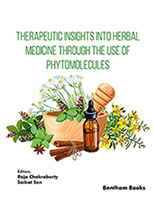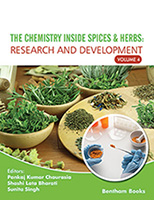Preface
Civilizations throughout human history have benefited from the taste, aroma, and benefits of spices and culinary herbs. They contain among the most valued natural products for their culinary and recreational uses and medicinal properties. Many of them have become integral parts of traditional systems of medicine. In recent decades they have been the focus of extensive scientific research. Their remarkable health benefits have been demonstrated through numerous phytochemical, pharmacological and clinical studies.
The 3rd volume of the book series entitled, “Science of Spices and Culinary Herbs” is a compilation of eight excellent review articles, presenting the latest developments in this exciting field of natural product sciences. They cover a whole range of topics, all relevant to the evidence based therapeutic, nutritional, and olfactory uses of common spices and herbs.
The review by Marcelino et al is focused on the anthelmintic properties of cinnamon (Cinnamomom verum J. Presil.). Various helminthes parasites are associated with a plethora of diseases in host plants, farm animals, and humans. Several gastrointestinal diseases are also caused by helminthes is humans. The authors have provided a comprehensive chapter covering the scientific studies on anthelmintic properties of cinnamon and uses in agriculture crops, livestock, and humans. More at al have contributed a chapter on the nutraceutical and other important biological properties of tamarind (Tamarindus indica L.), used globally as a fruit, and as a spice. The authors have presented the advances in phytochemistry and in clinical research on this globally important dietary plant. The next review by Oyetaya and Odeniyi is also focused on the nutritional and health promoting phytochemicals of tamarind. Turmeric (Curcuma longa Linn.) has been the focus of vigorous researches since the last several decades. Sukandar and Ayuningtyas have provided a comprehensive account of recent clinical studies conducted on various turmeric based formulations including its phytoconstituents. The review focuses on the importance of well-designed clinical trials and proper formulations in the context of turmeric based medications. Pimple et al have written a well referenced and well written chapter on culinary and perfumery properties of the famous herb oregano (Origanum majorana Linn.), focusing on its traditional uses, phytochemistry, and on its medicinal and perfumery importance. Soni et al discuss the medicinal constituents of black pepper (Piper nigrum L.), most important among which is piperine a pungent alkaloid. Preclinical pharmacological data supports the therapeutic potential of black pepper and its constituents. Coriander (Coriandrum sativum L.) is a herb of global significance. Upaganlawar et al have focused the recent work on therapeutic importance of this famous herb as well as its phytochemistry and pharmacognosy. Soni and Soni in the last chapter of this volume have reviewed recent work on the increasingly popular spice flax seed (Linum usitatissimum L.). Extensive studies on its nutritional and medicinal constituents followed by pharmacological and preclinical studies, have shown it to be a valuable functional food for physical and mental health.
We gratefully acknowledge scholarly contributions and timely submissions of their review articles by leading experts in this field. We also appreciate the diligent work of Ms. Fariya Zulfiqar (Manager Publications) and Mr. Mahmood Alam (Director Publications) at Bentham Science Publishers. We sincerely hope that this volume will greatly benefit the scientific community interested in the fascinating science of spices and herbs.
Atta-ur-Rahman, FRS
Kings College
University of Cambridge
Cambridge
UK
M. Iqbal Choudhary & Sammer Yousuf
H.E.J. Research Institute of Chemistry
International Center for Chemical and Biological Sciences
University of Karachi
Karachi, Pakistan





